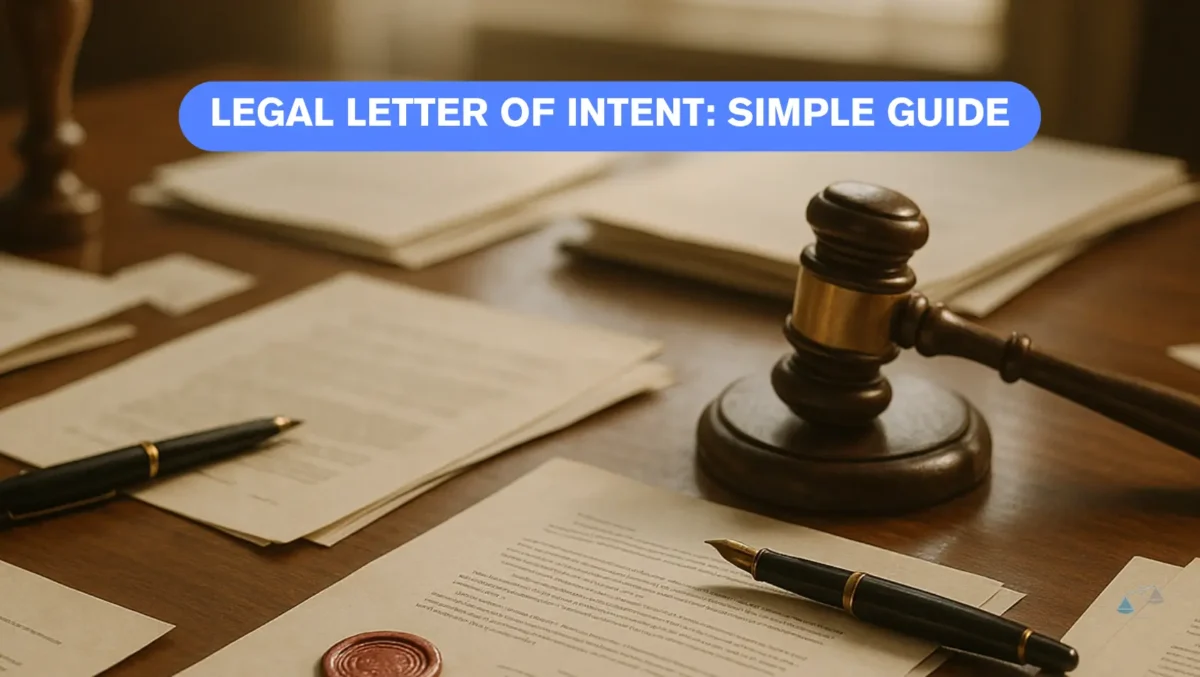Legal Letter of Intent: Definition and Examples

- Legal Letter of Intent: Definition and Examples
- Meaning of a Legal Letter of Intent
- The Legal Foundation of a Letter of Intent
- Key Determinants of Enforceability:
- Key Components of a Legal Letter of Intent
- Common Sections of an LOI
- How Letters of Intent Work in Legal Practice
- Real-World Examples of Letters of Intent
- 1. Business Acquisition (M&A)
- 2. Real Estate Transactions
- 3. Employment Agreements
- 4. Joint Ventures and Partnerships
- Why Legal Letters of Intent Matter
- Key Benefits
- Limitations and Legal Risks
- Common Risks
- Best Practices
- FAQ — Legal Letter of Intent (LOI)
- What is the purpose of a legal letter of intent?
- Is a letter of intent legally binding?
- What are the key elements of a letter of intent?
- How does a letter of intent differ from a contract?
- Can a letter of intent be revoked?
- When is a letter of intent used?
- What happens if a party breaches a letter of intent?
- What are common mistakes when drafting an LOI?
- Does signing a letter of intent mean a deal is guaranteed?
- Why do lawyers recommend using letters of intent?
- Author & Editorial Note
- Table of Contents
Simple definition of a legal letter of intent (LOI): a formal document that outlines the preliminary understanding between two or more parties before a legally binding contract is executed. It records mutual intentions, key terms, and negotiation boundaries — showing serious commitment without finalizing obligations.
“A letter of intent is the handshake before the contract — written proof that both sides mean business.”
Meaning of a Legal Letter of Intent
A Letter of Intent (LOI) is a written expression of good faith between parties entering negotiations for a future agreement. While it is not always legally binding, it clarifies expectations and ensures that discussions proceed within agreed parameters. LOIs are common in business transactions, mergers and acquisitions (M&A), real estate deals, joint ventures, and employment negotiations.
The core function of a legal LOI is to define intent without final obligation. It sets out what the parties agree on so far — such as purchase price ranges, confidentiality terms, timelines, and exclusivity periods — while acknowledging that a formal contract will follow. Some clauses (like confidentiality or exclusivity) can be legally binding even before the final deal is signed.
A well-drafted LOI helps:
- Prevent misunderstandings during negotiation.
- Establish trust and serious engagement.
- Serve as a framework for drafting the final agreement.
- Define binding vs. non-binding provisions clearly.
In legal practice, the distinction between intent and commitment is critical. Courts often examine wording, tone, and context to determine whether an LOI is enforceable. For example, if a letter includes specific promises or language like “shall purchase” or “must close,” it may be deemed binding despite the parties’ contrary intentions.
The Legal Foundation of a Letter of Intent
Although the term “letter of intent” suggests informality, it operates under fundamental contract principles. Whether an LOI becomes binding depends on offer, acceptance, consideration, and intention to create legal relations.
Key Determinants of Enforceability:
- Language Used: Words like “binding,” “shall,” or “must” signal enforceability, while “non-binding” or “for discussion purposes” show intent only.
- Clarity of Terms: Specificity can turn an LOI into a contract if essential elements (price, subject matter, timelines) are complete.
- Conduct of the Parties: Actions following the LOI — like transferring funds or sharing confidential data — may imply binding intent.
- Jurisdictional Interpretation: Courts differ; some view LOIs as moral guidelines, others as binding when reliance is proven.
The golden rule: if the parties intend to be bound, the LOI is binding. If they intend merely to negotiate, it’s not.
That’s why clarity in drafting is essential — vague or contradictory wording is the biggest cause of disputes.
Key Components of a Legal Letter of Intent
Although formats vary by transaction type, most LOIs share certain structural elements that help both sides align expectations. These sections strike a balance between legal caution and business practicality.
Common Sections of an LOI
| Section | Description | Binding? |
|---|---|---|
| Introduction & Purpose | States the goal and identifies parties | Non-binding |
| Transaction Outline | Summarizes key terms like price, assets, or scope | Usually non-binding |
| Confidentiality | Protects sensitive information shared during talks | Binding |
| Exclusivity (“No-Shop”) Clause | Prevents one party from negotiating with others temporarily | Binding |
| Due Diligence | Defines what information will be reviewed before final contract | Non-binding |
| Timeline and Closing Conditions | Sets milestones and tentative deadlines | Non-binding |
| Governing Law and Jurisdiction | Determines applicable legal framework | Binding |
| Termination Clause | Explains how and when negotiations may end | Binding or non-binding (context dependent) |
Well-crafted LOIs specify which sections are legally binding to avoid disputes later. Business lawyers often use bold labels like “(Binding)” or “(Non-Binding)” next to each clause for transparency.
How Letters of Intent Work in Legal Practice
A legal LOI bridges informal negotiation and formal contract. Once both parties sign, it typically initiates the due diligence phase — a detailed review of financial, operational, or legal data. This process allows each side to confirm that the deal is worth pursuing before drafting the final agreement.
For example:
- In M&A deals, an LOI might confirm the target company’s valuation and outline payment methods.
- In real estate, it may describe the property, price, and inspection period.
- In employment, it may outline compensation and position before a formal offer letter.
Once due diligence concludes, parties use the LOI as a blueprint for the final contract, ensuring alignment and minimizing surprises.
Real-World Examples of Letters of Intent
Letters of Intent appear across industries, each tailored to specific legal and commercial needs. Though the wording changes, the underlying purpose—clarifying intent before commitment—remains the same.
1. Business Acquisition (M&A)
A corporation planning to buy another company uses an LOI to set initial terms:
- Proposed purchase price and payment structure
- Outline of assets or shares to be acquired
- Due diligence scope and exclusivity period
- Timeline for signing the final purchase agreement
Example:
Company A signs an LOI to acquire Company B for $10 million, contingent upon satisfactory financial audits within 60 days. During that time, Company B agrees not to entertain other offers. If due diligence is successful, both parties proceed to finalize the deal.
2. Real Estate Transactions
In property sales or commercial leasing, an LOI outlines:
- Description of the property
- Purchase price or rental rate
- Closing date and inspection conditions
- Deposit and escrow arrangements
Example:
A developer submits a Letter of Intent to buy a plot of land for a housing project. The LOI grants 45 days for site inspection and environmental review. Only after both parties agree on findings does a binding sale contract follow.
3. Employment Agreements
Employers use LOIs (often called “offer letters”) to confirm intent before drafting a full employment contract.
It specifies:
- Job title and responsibilities
- Salary and benefits
- Start date and location
- Confidentiality or non-compete provisions
Although typically non-binding, these letters help avoid disputes about promised terms.
4. Joint Ventures and Partnerships
When two entities explore collaboration, an LOI clarifies:
- Purpose and scope of partnership
- Resource contributions
- Profit-sharing structure
- Governing law and dispute resolution
This prevents misunderstandings before formalizing a joint venture agreement.
Why Legal Letters of Intent Matter
Legal Letters of Intent matter because they bridge the gap between negotiation and commitment, allowing parties to move forward confidently while protecting their interests. They strike a delicate balance: formal enough to demonstrate intent, yet flexible enough to withdraw if due diligence reveals issues.
Key Benefits
- Reduces Risk of Misunderstanding: Defines expectations early.
- Encourages Efficient Negotiations: Provides a roadmap for drafting the final deal.
- Enhances Professionalism: Signals seriousness and transparency.
- Protects Confidentiality: Legally binds sensitive information even before the contract.
- Supports Financing or Approvals: Investors or regulators often require an LOI before granting approval.
In many industries, an LOI is also a psychological commitment — once signed, both sides are invested in the transaction. Abandoning negotiations afterward can harm reputation or business credibility.
Limitations and Legal Risks
Despite its usefulness, an LOI can cause disputes if not drafted carefully. The main challenge lies in ambiguity — when parties disagree about which parts are binding. Courts analyze the wording, structure, and conduct to determine intent, often leading to litigation.
Common Risks
- Accidental Binding Effect:
Overly detailed terms can transform a non-binding LOI into a contract. - Vague Language:
Ambiguity over key terms (like price or scope) can lead to conflicting interpretations. - Premature Reliance:
Acting on an LOI (e.g., spending money or canceling other deals) may trigger equitable claims such as promissory estoppel. - Confidentiality Breaches:
Sharing trade secrets or financial data without proper binding clauses invites misuse. - Breakdown in Negotiations:
If one party walks away after prolonged discussions, the other may claim damages for reliance or bad faith.
Best Practices
- Use explicit labels: Mark each clause as Binding or Non-Binding.
- Avoid absolute language: Replace “shall” with “may” or “intend to.”
- Consult legal counsel: Professional review ensures enforceability and fairness.
- Keep it concise: Include only key business terms; save details for the final contract.
- Reiterate purpose: Add a concluding statement clarifying that the document is a letter of intent, not a final agreement.
In short, a Legal Letter of Intent is both a safeguard and a potential pitfall. When written clearly, it sets the stage for successful deals; when drafted carelessly, it invites confusion and legal exposure.
Used wisely, an LOI transforms informal interest into structured progress — bridging intent and execution in the world of contracts.
FAQ — Legal Letter of Intent (LOI)
What is the purpose of a legal letter of intent?
Its purpose is to record the preliminary understanding between parties before signing a final contract. It clarifies terms, builds trust, and defines the next steps in negotiation without creating full legal obligations.
Is a letter of intent legally binding?
Not always. Most LOIs are partly binding—for example, confidentiality, exclusivity, or governing law clauses may be enforceable, while the rest remain non-binding. The binding nature depends entirely on how the document is worded.
What are the key elements of a letter of intent?
Typical sections include the purpose of the deal, proposed terms, confidentiality, exclusivity, due diligence, governing law, and termination rights. Each should specify whether it is binding or non-binding to prevent future disputes.
How does a letter of intent differ from a contract?
A contract creates enforceable obligations; a letter of intent outlines future intentions. The LOI marks serious interest but leaves room for change until the final agreement is executed.
Can a letter of intent be revoked?
Yes. Unless the LOI explicitly states otherwise, either party may withdraw before signing a final agreement. However, withdrawal must not violate binding provisions like confidentiality or exclusivity.
When is a letter of intent used?
LOIs are used in mergers and acquisitions, real estate transactions, employment offers, partnerships, and financing deals—essentially any negotiation where parties want clarity before drafting a binding contract.
What happens if a party breaches a letter of intent?
If the breached clause is binding (for example, confidentiality), the injured party may sue for damages or injunctions. For non-binding provisions, remedies are usually unavailable unless reliance or bad faith is proven.
What are common mistakes when drafting an LOI?
Mixing binding and non-binding clauses without clarity
Using mandatory language (“shall,” “must”) unintentionally
Omitting jurisdiction or governing law
Failing to label each section’s legal effect
Does signing a letter of intent mean a deal is guaranteed?
No. It signals intent, not completion. The deal remains subject to due diligence and negotiation of a final contract.
Why do lawyers recommend using letters of intent?
Because they organize negotiations, reduce misunderstandings, and protect sensitive information. An LOI provides structure and legal foresight before significant commitments are made.
Author & Editorial Note
Author: Legal Terms
Last Updated: October 2025
Disclaimer: This content provides general educational information about Letters of Intent (LOIs). It is not legal advice and may vary by jurisdiction.






